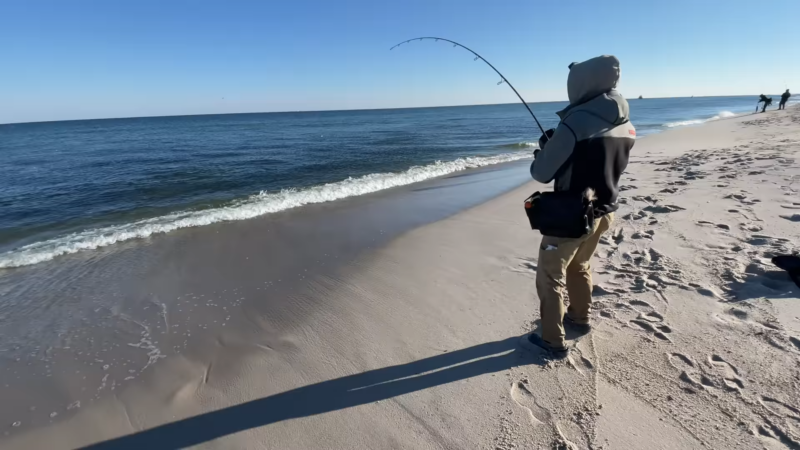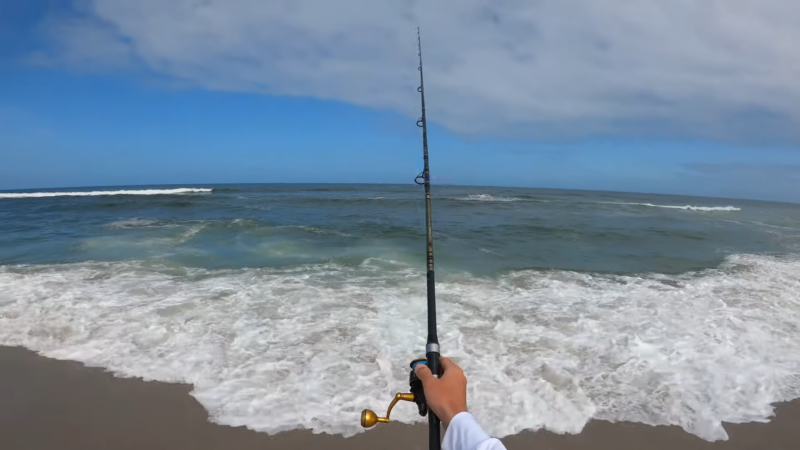Fishing in Brigantine, NJ, offers some of the best experiences you’ll find in the area.
This island city is renowned for its rich marine life and scenic waters, making it a favorite among anglers.
Let us talk about the main fishing spots in this town.
Getting to Know Brigantine’s Waters

Brigantine, NJ, offers diverse fishing environments shaped by the Atlantic Ocean, local weather, and rich marine life.
Recognizing how these elements interact will improve your fishing experience.
Brigantine’s fishing success relies heavily on understanding the local weather patterns.
The Atlantic Ocean’s influence means that you often encounter varying conditions.
- Spring: Cool and unstable. Expect a mix of sunny and rainy days. Winds often come from the northwest.
- Summer: Warm and steady. You’ll find more sunny and calm days, with gentle east or southeast breezes.
- Fall: Crisp and changing. This season sees frequent weather shifts, with winds prevalent from the northeast.
- Winter: Cold and harsh. Fewer fishing days due to strong winds and stormier weather.
These patterns affect sea temperature and fish activity. A keen eye on the forecast can help you plan your trips on the most productive days.
Overview of the Atlantic Ocean Ecosystem

Brigantine’s waters are part of the Atlantic Ocean, home to diverse marine life.
You will encounter fish species like striped bass, bluefish, flounder, and weakfish.
- Shallow Waters: Near the beach and inlets, where fish are found hunting for smaller baitfish.
- Deeper Waters: Further out, where larger species swim and look for food. This is ideal for more experienced anglers.
The Atlantic also hosts plentiful baitfish, making it a prime location for bigger catches.
Keep your eyes peeled for birds diving into the water—a sign of fishing activity below. Knowing these ecosystem details helps you understand where and when to cast your line.
Prime Fishing Locations in Brigantine
Brigantine offers a variety of fishing experiences including beachside fishing, reef exploration, and freshwater spots.
The following areas provide diverse opportunities for anglers of all skill levels.
The Abundance at Brigantine Beach

Brigantine Beach is an epicenter for local fishing. Located between Atlantic City and Long Beach Island, this beach is perfect for surf fishing.
Spring and fall are particularly productive seasons when you can expect to catch:
- Stripers
- Black drum
- Bluefish
Early mornings and late evenings are the best times for fishing here. Access is easy with plenty of parking spots.
Some sections of the beach allow off-road vehicles, which is helpful if you want to bring more gear.
Exploring the Reefs and Jetties

The reefs and jetties in Brigantine provide an exciting fishing experience. Absecon Inlet, at the southern end, is a notable spot.
With its partly fishable jetty, this location attracts a variety of species like flounder, sea bass, and tautog. Using live bait or lures is effective here.
Be mindful of the tides, as fishing is often best when the water is moving. Access to these spots is relatively straightforward, though certain areas may require careful navigation over rocky terrain.
Freshwater Fishing at the Local Cove and Dam
For those interested in freshwater fishing, the local cove and dam offer a serene alternative.
These areas are less crowded and are perfect for catching species like bass, crappie, and ocean sunfish.
Early mornings provide calm waters and a peaceful experience.
Gear up with lighter tackle to match the freshwater species and consider bringing a kayak or small boat for better access to deeper parts of the cove.
This combination of varied fishing locations ensures that whether you enjoy surf fishing, the challenge of rocky reefs, or the tranquility of a cove, Brigantine has got you covered.
Seasonal Fish Movements

Fishing in Brigantine is a year-round activity, but knowing which fish to target and when can make a huge difference.
Each season brings its own set of fish species that are more active and easier to catch.
Spring and Summer Favorites
In spring, flounder and black drum can be found in the warmer waters as they move inshore to spawn.
Stripers and bluefish are also popular during this time.
As summer approaches, mahi mahi and summer flounder become the primary targets.
Mahi mahi are often found further offshore, a bit past the inlets, where the water is warmer.
Summer flounder are more common nearshore and around inlets, providing great opportunities for shore and boat anglers alike.
Fall and Winter Targets
As fall sets in, striped bass (also known as stripers) become the main attraction.
They migrate south along the coast, making Brigantine a prime spot for catching them. Redfish also show up more frequently in the fall, providing thrilling fights for anglers.
Winter fishing can be more challenging, but stripers are still around, especially in deeper waters. Additionally, the colder months may bring some redfish closer to shore, creating perfect conditions for surf fishing.
Fishing Tactics and Gear Essentials

For those venturing into Brigantine’s waters, having the right gear and knowing the tactics can make all the difference.
From choosing local-specific tackle to mastering various techniques, understanding your equipment is key.
Choosing the Right Tackle for Local Species
Selecting the correct tackle can influence your success in Brigantine. Striped bass often respond well to topwater lures and spinnerbaits.
For tautog and summer flounder, you might prefer jigs and spoons. Bluefish are active in the spring and will strike at various baits.
Make sure to have a mix of these options.
- Topwater lures: Great for surface-feeding fish like striped bass.
- Spinnerbaits: Ideal for attracting predatory fish with their flashy blades.
- Jigs and Spoons: Effective for bottom-dwelling species like flounder and tautog.
Fishing Rod and Reel Dynamics

Choosing the right rod and reel is crucial.
For surf fishing, a longer rod (9-12 feet) provides a better casting distance.
Medium-heavy rods offer the flexibility needed for different fish sizes.
Pair these with spinning reels for ease of use.
- Fly fishing rods: Best for light, precise casting, particularly in calm water.
- Spinning reels: Versatile and user-friendly, suitable for beginners and seasoned anglers.
- Conventional reels: Offer greater control for large fish and are preferred in deep waters.
Match your rod and reel to your targeted fish to optimize your efforts.
This also ensures a balanced setup, making your fishing experience more enjoyable and effective.
Mastering Different Fishing Techniques

Different techniques suit different conditions and species. Surf fishing is productive along Brigantine’s beaches where you cast beyond the breaking waves.
Try drifting in the inlets for species like flounder. Bottom fishing excels near structures where tautog and sea bass congregate.
- Topwater fishing: Engaging for species like bluefish and striped bass, especially during dawn.
- Drift fishing: Effective in areas with strong currents, targeting flounder.
- Bottom fishing: Best around reefs, wrecks, and rocky areas for tautog and sea bass.
Adapt your technique based on the season and your target species for the best results. This flexibility not only improves your catch rate but also enriches your overall fishing experience.
Local Fishing Regulations

Fishing in Brigantine requires knowing the rules and supporting practices that protect the local marine environment. This ensures sustainability for future generations while providing a fantastic outdoor adventure for anglers today.
Obtaining Fishing Licenses and Understanding Limits
You need a fishing license to fish in Brigantine. Residents and non-residents can obtain licenses online through the state’s official website or at local bait and tackle shops.
Prices vary, with discounts available for senior citizens and veterans.
Fishing limits are set to protect fish populations. These include size and bag limits.
For example, summer flounder must be at least 18 inches, and you can catch up to three per day.
Keeping updated on regulations is crucial, as they change seasonally. Make sure to check the latest guidelines before heading out.
Supporting Sustainable Fishing and Marine Life Protection
Sustainable fishing practices help maintain the balance in the ecosystem.
This includes catch-and-release methods, especially for species not in season or those protected by conservation laws. Use barbless hooks to reduce injury to fish and ensure safe release.
Community efforts, such as beach clean-ups and participating in local conservation programs, also play a significant role. Engage with groups that focus on marine life protection to stay informed about local initiatives.
For example, Riptide Bait and Tackle often collaborate on sustainability projects, providing resources and support to fishing enthusiasts.

